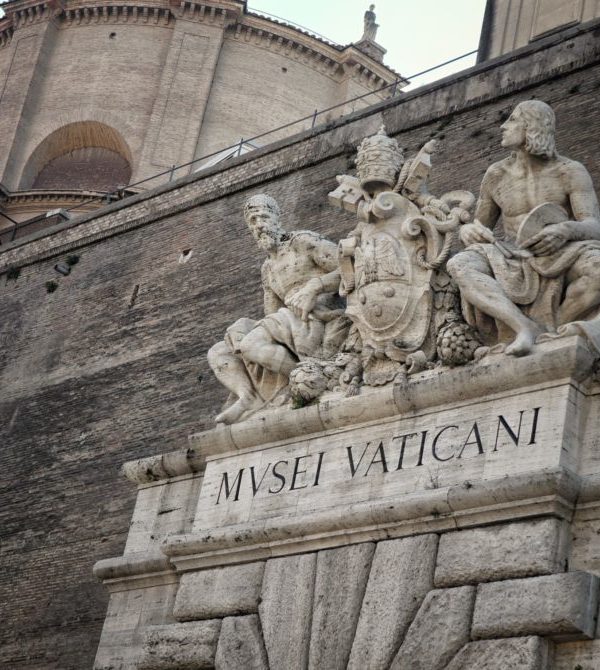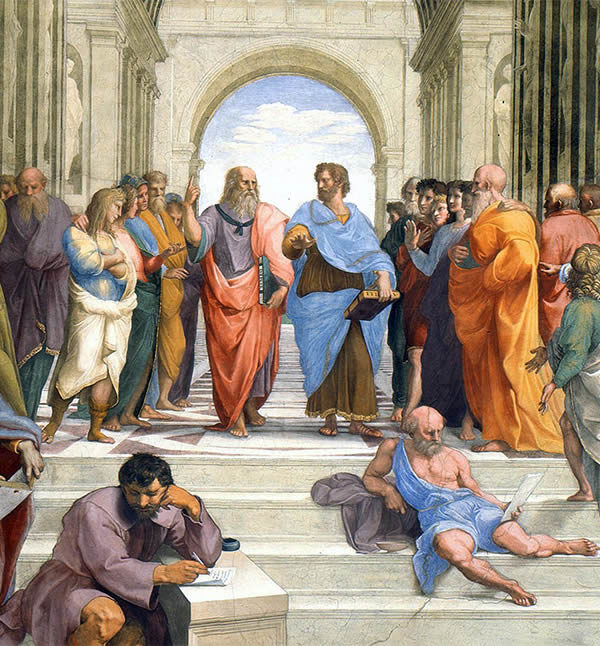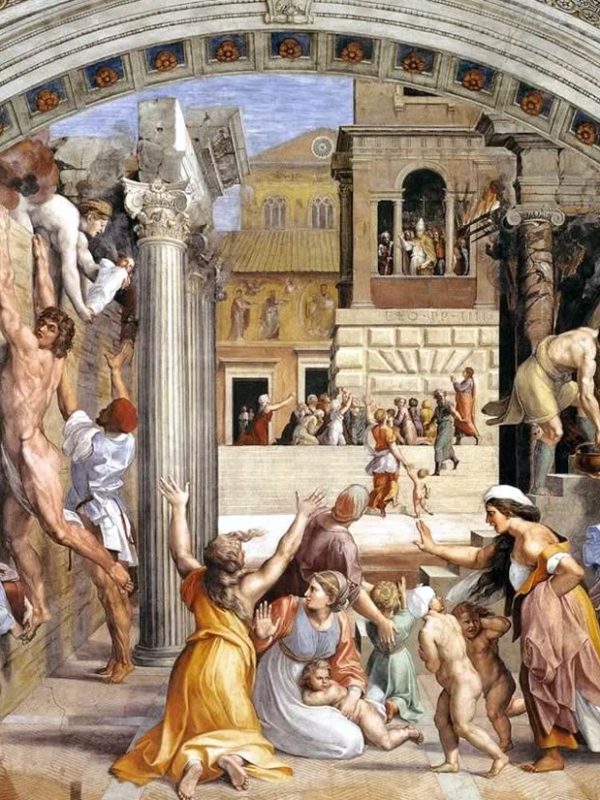The atrium (corresponding to the ancient portico of the early Christian basilicas) is considered one of the most valuable works of Carlo Maderno and was built between 1608 and 1612.
The central portal, the work of the Florentine sculptor Antonio Averulino called il Filarete, is dated 1455 and was relocated here by the ancient Constantinian church: among them are represented, among others, San Pietro and San Paolo, and below, their martyrs.
On the right is the Holy Door, made in bronze by the sculptor Vico Consorti in 1950: it opens and closes in the presence of the Pope during each Jubilee. On the bottom in the left vestibule is the equestrian monument of Charlemagne, the work of Agostino Cornacchini (1725), in the right vestibule there is the statue of Emperor Constantine on horseback, made by Bernini in 1670.
The Latin cross structure of the interior is due to the intervention of Carlo Maderno who, starting from the early 1600s, completed the construction of the St Peter’s Basilica and built the three bays of the central nave and the two lateral aisles, forming a unitary whole with the core Michelangelo of the central octagon. It is a grandiose, immense space, decorated with a large quantity of stuccos, mosaics and statues with a typically Baroque imprint, in which the visitor almost experiences a sense of loss; perhaps it is necessary to stop for a few moments to get used to its dimension which can be focused by comparing the height of people with that of the “holy water fonts” and the putti that support them.
The St Peter’s Basilica is 187 meters long, 58 meters wide and 140 meters wide at the level of the transept; the maximum height of the vault in the central nave is 46 meters (like a 15-story building!).
For the visit it is advisable to go through the central space to the point where the lengths of the largest churches in the world are marked on the floor; then to return to the side aisle near the front door.
The central nave is marked by powerful pillars with high fluted and rudent pilasters (the lower part of the grooves is full), inside which niches open containing 39 figures of Saints founders of the Orders and religious Congregations; the ceiling is decorated with gilded stuccos executed in 1780 under Pius VI.
In the right aisle, looking at the altar, there are numerous works of great artistic and religious value together. In the first chapel, protected by a thick crystal, is the Pietà, Michelangelo’s youthful masterpiece, painted in 1499 when the artist was just 24 years old: the Madonna with the youthful and very sweet face, almost resigned in the face of destiny, holds in her lap the dead Christ, with a softly abandoned body; the articulated drapery of the robe and veil, however, reveal an extraordinary strength, which is both physical and moral, which is contrasted by the refined features of the face, still entirely from the fifteenth century; the work is the only one signed by the artist on the belt.
Then follows the Chapel of the Blessed Sacrament, on whose altar there is a ciborium inspired by the temple of San Pietro in Montorio del Bramante, on the Janiculum hill. This gilded bronze sculpture was made by Bernini in 1674 and was later completed with two kneeling angels. At the end of the right nave is the funeral monument to Gregory XIII (1572-1585), a work that the sculptor Camillo Rusconi finished in 1723, with allegorical figures of Religion and the Fortress and a dragon, heraldic symbol of the family. under the sarcophagus.
Returning to the central nave you will meet the famous statue of St. Peter blessing, a bronze work attributed almost by the critics to the sculptor Arnolfo di Cambio (1245-1302); some scholars argue instead that it dates back to the fifth century. Note the foot consumed by the kiss of the faithful, who express in this way their devotion to the Saint.
The intersection between the longitudinal nave and the transept is marked by four powerful square pillars. In the internal faces of the pillars niches are dug that house four colossal statues, personifications of as many crucial moments of the passion of Christ: San Longino, the soldier who with his spear opened the side to Jesus and later converted to Christianity, the work of Bernini in 1638 ; Saint Helena, mother of Emperor Constantine, who brought the cross and nails of martyrdom to Rome; Saint Veronica, who with a cloth would have wiped the face of Christ on the road to Calvary, and finally Saint Andrew, brother of Peter, crucified in Greece. These last three statues are from the Bernini school.
At the center of the church the papal altar is dominated by the famous bronze Baldacchino, Bernini’s early work, carried out between 1624 and 1632. 29 meters high, it was commissioned by Pope Urban VIII Barberini (1623-1644) to fill the “void” below the dome thus creating an upward motion. For its fusion, bronze tiles were used that adorned the ceiling of the pronaos of the Pantheon, from which the famous saying quod non fecerunt barbari fecerunt Barberini (what the barbarians did, the Barberini did). The Baldacchino is composed of four colossal spiral columns decorated with spiral grooves, olive and laurel branches, and a composite capital; the roof, with volutes and angular statues of extraordinary elegance, culminates with a golden bronze sphere. Note the tassels with bees (heraldic coat of arms of the Barberini which indicated their industriousness), which seem to almost simulate the effect of the wind on the canopy after a transport carried out in a rush. Inside is a golden dove, a symbol of the Holy Spirit.
At the level below there is the “tomb of San Pietro”, where, according to tradition, the remains of the Apostle are kept: this has made it one of the most revered places by Christians and made it the chosen site for building the maximum temple of Christianity. Recent archaeological investigations seem to confirm the veracity of the tradition.
Above the Baldacchino stands the majestic dome, whose internal decoration was made on cartoons by Giuseppe Cesari, called Cavalier d’Arpino, between 1603 and 1613. The Latin inscription at the base of the dome reads thus: “You are Peter , and on this stone I will build my Church and I will give you the keys of the kingdom of heaven “.
In the right transept we must mention the monument to Clement XIII (1758-1769), the work of the greatest Italian neoclassical sculptor, Antonio Canova. Commissioned in 1784, it is made on the model of Bernini’s sepulchres, with the portrait of the pope above the sarcophagus flanked by allegorical figures: it is the Religion with the cross in hand and the funerary Genius that extinguishes the torch of life; two lions take turns watching over the sepulcher.
The Altar of the Chair is one of Bernini’s sculptural masterpieces.
Inside the large oval window, closed by an alabaster plate with rays that divide the surface into twelve sectors to symbolize the Apostles, there is the dove of the Holy Spirit. Around it there develops an extraordinary cloud made of angels and cherubs that surmount the bronze Chair of Peter. In this is preserved a wooden throne which, according to tradition, would have been the chair of the first apostle; in reality it is a gift from the French king Charles the Bald made to the pope in 875. The two fathers of the Latin Church, Sant’Ambrogio and Sant’Agostino, and the two of the Greek Church, Sant’Atanasio and San Giovanni Crisostomo flank the throne. The work was completed in 1666 under Pope Alexander VII.
On the sides the funeral monuments to Paolo III by Guglielmo della Porta (on the left), and the one in Urban VIII by Bernini (on the right).
Another sculpture of great artistic importance is the one in the left transept dedicated to Alexander VII, Bernini’s last effort, made when the artist was eighty years old, commissioned by the same pontiff.
The skeleton, which appears below the red cloth, and the hourglass symbolize the passage of time and the inevitability of death.
In the left nave there is the Antonio Canova monument to the Stuart family (1819), dedicated to the last descendants of the valiant English family, profile portraits under the shelf.
Finally, the monument to Pope John XXIII (1958-1963) is by the sculptor Emilio Greco (1964-1967).



